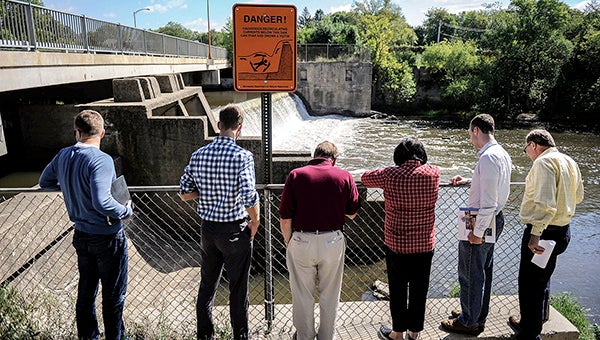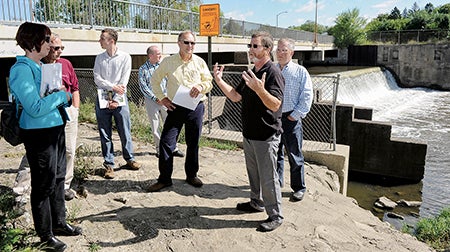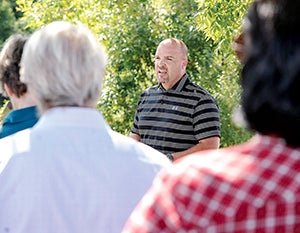Dam good proposals; Austin hosts state bonding committee, reviews waterways projects
Published 10:51 am Friday, September 11, 2015

Visitors with the House Capital Investment committee group touring Austin look down at the Fourth Avenue Dam Thursday morning where they heard about some of the projects Austin leaders want for the area. — Photos by Eric Johnson/photodesk@austindailyherald.com
Austin officials got the chance to sell the city’s upcoming water-related needs to state lawmakers Thursday when the House Capital Investment Committee toured the area to learn about flood mitigation, waterways plans and more.
“It’s just fantastic to be able to show what we’re doing,” City Administrator Craig Clark said.
The committee, which includes Rep. Jeanne Poppe, DFL-Austin, toured part of the Cedar River Watershed District, the Fourth Avenue Northeast dam on the Cedar River, and the Ramsey Dam north of Austin.

Austin Mayor Tom Stiehm welcomes members of the House Capital Investment committee to Austin near the Fourth Avenue Dam Thursday morning.
Austin has made huge strides in improving its flood mitigation ever since the city sought a $27 million, 20-year local option sales tax from state lawmakers in 2006. The city has completed several projects over the years, including the $14 million North Main Flood Control project along the Cedar River in downtown Austin.
Yet various local entities hope the Capital Investment Committee will award dollars to area projects during next year’s legislative session. The Cedar River Watershed District is looking to secure $4.2 million as part of its five-year plan to tackle 25 projects in the watershed to improve storm water detention, ravine stabilization and reduce flood risks.
The CRWD recently received a $3.2 million grant from the Hormel Foundation as part of the plan.
In addition, the city of Austin and Vision 2020 are partnering with several area groups to improve the Ramsey Dam area.

Assistant City Engineer Stephen Lang briefs local dignitaries and memebers of the House Capital Investment committee on some of the future projects Austin is hoping to do with Ramsey Dam.
The city is seeking state bonding dollars to acquire more land, build two miles of trail, restore a railroad bridge, improve Ramsey Dam’s flood mitigation and build public amenities to improve the area.
The project would cost about $3 million.
“It’s good to be able to show the bonding committee the infrastructure of the projects we have here,” Poppe said. “We in the past have talked about flood mitigation only and solely as being our need here. Now, this is really just the pieces of the puzzle that all work together [to improve the area’s waterways].”
This is the third of five trips the committee has made around the state this fall as legislators get ready for the next legislative session. The committee has received about $3.2 billion in requests across Minnesota but will only be able to fund about a quarter of those proposals, according to committee chair Rep. Paul Torkelson, R-St. James.
“It’s an ongoing concern but it’s not the only concern we’re hearing about,” Torkelson said of the area’s water infrastructure needs.
Austin and the Mower County area are focusing on the bigger picture when it comes to water after years of flood concerns. The city of Austin is working with the Minnesota Pollution Control Agency as one of the first communities to be hit with new phosphorous regulations when it comes to treating wastewater. The city estimated it would cost about $20 million total to improve its wastewater treatment plant, with half of that cost going directly before taxpayers.
MPCA officials have told City Administrator Craig Clark they would study how those regulations would affect communities before putting an official cost on its new regulations.
The city of Austin’s wastewater license with the MPCA expired earlier this summer, but the city is working with the MPCA on a provisional basis while the MPCA reviews the effects of its regulations.



